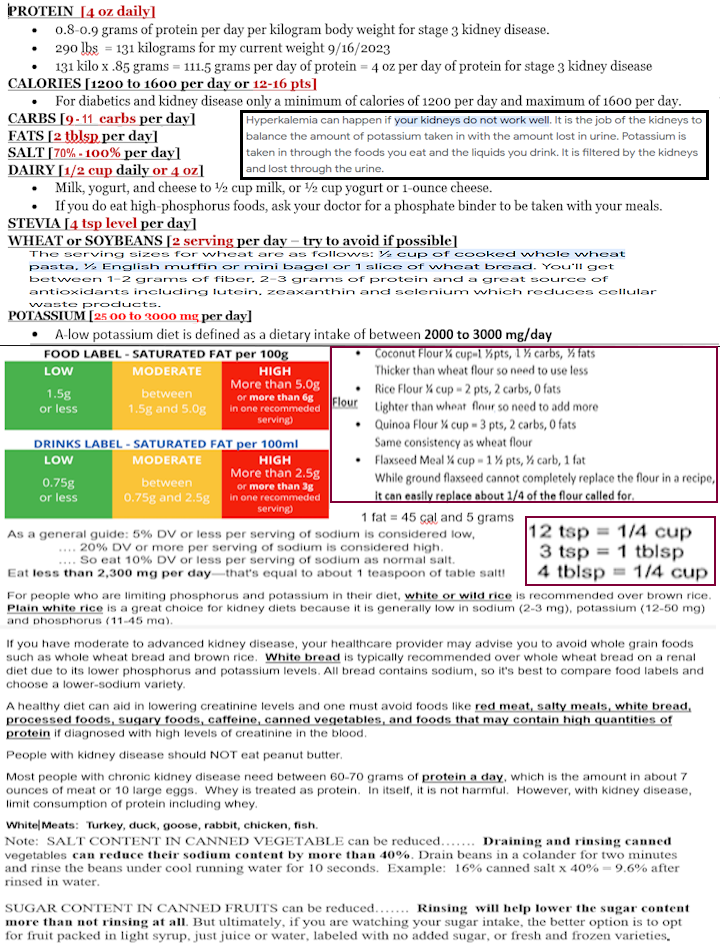
Pineapple, cranberries, red grapes, and apples are all kidney-friendly fruits with anti-inflammatory properties are good fruits for Kidney Disease.
The best beverage to drink on a kidney diet is 2 liters of water. Sparkling water, lemon water, and [unsweetened] green teas are also good options. Lemon-lime soda [diet], lemonade [diet], and root beer [can only have clear soda and diet] are low in phosphorus, although they can be high in added sugars unless you drink diet soda with no sugars.
Limit intake of foods with high levels of phosphate or phosphate additives such as organ meats, whole grain breads, processed foods, cola beverages, cheese, dried beans, liver, peanut butter, dairy products and chocolate.
SALT:
- ¼ tsp salt = 575 mg = 15% of 2300 mg
- ½ tsp salt = 1150 mg = 50% of 2300 mg
- ¾ tsp salt = 1725 mg = 75% of 2300 mg
- 1 tsp level salt = 2300 mg = 100% of 2300 mg
Body needs only 500 mg of salt per day, however.
Kidney disease diet should be no more than 65% salt per day.
PROTEIN: 1000 mg = 1 gram
- 7 grams = 1 oz
- 21 grams = 3 oz
- 28 grams = 4 oz
STEVIA SWEETENER:
The World Health Organization defines the acceptable daily intake (ADI) as 4 mg of stevia per kilogram of body weight. According to an FDA estimate, that means a 150-pound person could safely eat up to 10 packets of stevia a day—way more than you actually need, considering its intense sweetness.
FAT: I am not discerning between saturated and other fats, but grouping all fats under “fat”.
- One teaspoon equals about five grams of fat. 12 teaspoons, which is the same as ¼ cup. If you’re following a 2,000-calorie-a-day diet, your target range for total fat is 44 to 78 grams a day.
- So for 1200 to 1600 calorie diet, 26.4 to 48.8 grams a day.
- 5 servings of 5 grams = 26 appx grams a day which equals 5 tsp which is one tblsp + 2 tsp of fat
- 10 servings of 5 grams = 50 appx grams a day which equals 10 tsp which is less than ¼ cup of fat
Thus, I am considering maximum fat allowed to be 1 tblsp + 2 tsp to 3 tblsp + 1 tsp.
SOYBEANS:
Soy foods may be beneficial for people with chronic kidney disease (CKD), dialysis patients and those with a kidney transplant as a low-saturated fat, cholesterol-free meat replacement. Similar to animal protein, soy is also a high quality protein, but is plant-based instead.
And we found that dietary soy was associated with significant decrease of serum creatinine, serum phosphorus, CRP (C reactive protein)and proteinuria in the predialysis subgroup.
Soy products contain large amounts of chemicals called oxalates. Oxalates are the main ingredient in kidney stones. If you have a history of kidney stones, avoid taking large amounts of soy. Milk allergy: Children who are very allergic to cow’s milk might also be sensitive to soy products. Some soy products can have high potassium, phosphorus, and sodium levels. Since large amounts of these nutrients can be harmful for people with kidney disease, we encourage you to carefully read food labels to learn the nutrient content in soy products. Eating too much of it can cause hormonal imbalance and thyroid issues.
Treatment for hypothyroidism usually includes taking the thyroid hormone medicine levothyroxine (Levo-T, Synthroid, others) every day. Research has shown that soy can make it harder for the body to absorb that medicine. But people who have hypothyroidism don’t need to avoid soy completely
Phosphatase
If you have high alkaline phosphatase levels, it is advisable to avoid or minimize alcohol intake to protect liver health. High-Sugar Foods and Beverages: High-sugar foods and beverages, such as sugary sodas, candies, pastries, and desserts, can contribute to weight gain and metabolic disturbances.
Which foods are omega-3 fatty acids?
Fish and other seafood (especially cold-water fatty fish, such as salmon, mackerel, tuna, herring, and sardines) Nuts and seeds (such as flaxseed, chia seeds, and walnuts) Plant oils (such as flaxseed oil, soybean oil, and canola oil)Jul 18, 2022